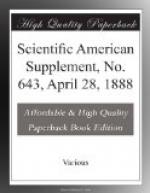* * * * *
VOLUTE DOUBLE DISTILLING CONDENSER.
This distiller and condenser which we illustrate has been designed, says Engineering, for the purpose of obtaining fresh water from sea water. It is very compact, and the various details in connection with it may be described as follows: Steam from the boiler is admitted into the evaporator through a reducing valve at a pressure of about 60 lb., and passing through the volute, B, evaporates the salt water contained in the chamber, C; the vapor thus generated passing through the pipe, D, into the volute condenser, E, where it is condensed. The fresh water thus obtained flows into the filter, from which it is pumped into suitable drinking tanks.
[Illustration: VOLUTE DOUBLE DISTILLING APPARATUS.]
The steam from the boiler after passing through the volute, B, is conveyed by means of a pipe to the second volute, H, where it is condensed, and the water resulting is conveyed by means of a pump to the hot well or feed tank. The necessary condensing water enters at J and is discharged at K. The method of keeping the supply of salt water in the evaporator at a constant level is very efficient and ingenious. To the main circulating discharge pipe, a small pipe, L, is fitted, which is in communication with the chamber, M, and through this the circulating sea water runs back until it attains a working level in the evaporator, when a valve in the end of pipe, L, is closed by the action of the float, N, the regulation of admission being thus automatic and certain. The steam from the boiler can be regulated by means of a stop valve, and the pressure in the evaporator should not exceed 4 lb., while the pressure gauge is so arranged that the pressure in both condenser and evaporator is shown at the same time. A safety valve is fitted at the top of the condenser, and an automatic blow-off valve, P, is arranged to blow off when a certain density of brine has been attained in the evaporator. The “Esco” triple pump (Fig. 3), which has been specially manufactured for this purpose, has three suctions and deliveries, one for circulating water, the second for the condensed steam, and a third for the filtered drinking water, so that the latter is kept fresh and clean.
The condenser and pumps are manufactured by Ernest Scott & Co., Close Works, Newcastle on Tyne, and were shown by them at the late exhibition in their town.
* * * * *
IMPROVED CURRENT METER.
Paul Kotlarewsky, of St. Petersburg, has invented an instrument for measuring or ascertaining the velocity of water and air currents.




